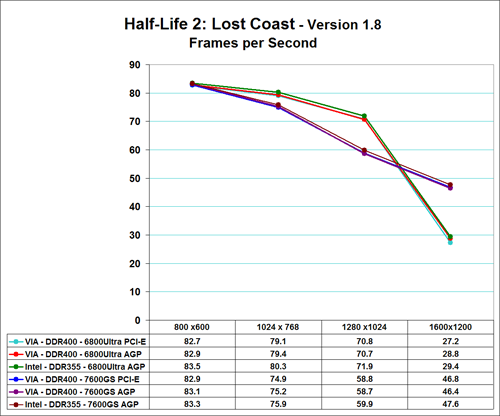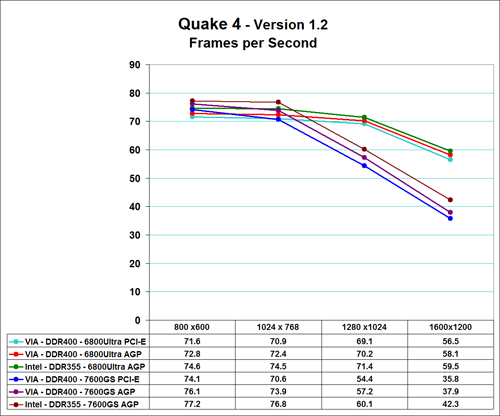ASRock Core 2 Duo: AGP/PCI Express Graphics Performance, Part Tres
by Gary Key on August 15, 2006 6:30 AM EST- Posted in
- Motherboards
Graphics Performance Comparison
While our previous articles concentrated on memory performance, today's article solely consists of gaming benchmarks and the synthetic 3DMark tests from Futuremark. The 3DMark series of benchmarks developed and provided by FutureMark are among the most widely used tools for benchmark reporting and comparisons. Although the benchmarks are very useful for providing consistent comparisons across a broad array of GPU and CPU configurations they are not a substitute for actual application and gaming benchmarks. In this sense we consider the 3DMark benchmarks to be purely synthetic in nature.
The gap between PCI-E and AGP solutions is less than 2% with both video card choices. Our first tests show AGP performing slightly better than PCI-E on the VIA platform with the Intel platform performing better overall. The 6800 Ultra series outperforms the 7600GS up to 38% in 3DMark05 and 26% in 3DMark06. Let's see if these differences carry over into our game benchmarks.
We utilized Far Cry, Half Life 2 and Quake 4 in our memory test articles because they are sensitive to memory changes and potentially bus throughput issues in our comparison. We added Prey and Serious Sam 2 to our benchmark mix because they are typically very GPU dependent and scale well. We originally tested at both 1024x768 and 1280x1024 resolutions at High Quality settings without anti-aliasing or antistrophic filtering enabled. We have also added 800x600 and 1600x1200 resolutions with the same settings.
Our three memory sensitive games show a consistent pattern with the AGP capability of the ASRock 775Dual-VSTA performing up to 5% higher than the PCI-E version in our testing. Overall, the AGP slot performance is better than the PCI Express slot even in 800x600 testing where the X4 operation handicap should not make a difference. The Intel 865 chipset offers better AGP performance especially as the resolutions start to scale upward. Looking at the gaming results from our previous article, the X16 PCI-E solutions typically offer equal or better performance than the AGP offerings. Whether it's the extra bandwidth or simply a less-than-perfect PCI-E implementation on the 775Dual-VSTA we can't say without further testing. However, the bottom line is that AGP performance is better than PCI-E performance on this particular motherboard.
The 6800 Ultra is still a very competitive card when compared to the 7600GS in these particular benchmarks, although it stumbles at 1600x1200 in Half Life 2- Lost Coast. The ATI X850XT-PE would score in a similar fashion if not better than the 6800 Ultra, though of course it lacks SM3.0 support which can be useful in more recent titles. Those owners with a graphics card in this class can still get by with most of today's games. We will have Oblivion results in our final article although we highly suggest going with a different solution to play this game at decent settings
While our previous articles concentrated on memory performance, today's article solely consists of gaming benchmarks and the synthetic 3DMark tests from Futuremark. The 3DMark series of benchmarks developed and provided by FutureMark are among the most widely used tools for benchmark reporting and comparisons. Although the benchmarks are very useful for providing consistent comparisons across a broad array of GPU and CPU configurations they are not a substitute for actual application and gaming benchmarks. In this sense we consider the 3DMark benchmarks to be purely synthetic in nature.
 |
| Click to enlarge |
The gap between PCI-E and AGP solutions is less than 2% with both video card choices. Our first tests show AGP performing slightly better than PCI-E on the VIA platform with the Intel platform performing better overall. The 6800 Ultra series outperforms the 7600GS up to 38% in 3DMark05 and 26% in 3DMark06. Let's see if these differences carry over into our game benchmarks.
We utilized Far Cry, Half Life 2 and Quake 4 in our memory test articles because they are sensitive to memory changes and potentially bus throughput issues in our comparison. We added Prey and Serious Sam 2 to our benchmark mix because they are typically very GPU dependent and scale well. We originally tested at both 1024x768 and 1280x1024 resolutions at High Quality settings without anti-aliasing or antistrophic filtering enabled. We have also added 800x600 and 1600x1200 resolutions with the same settings.
 |
 |
 |
| Click to enlarge |
Our three memory sensitive games show a consistent pattern with the AGP capability of the ASRock 775Dual-VSTA performing up to 5% higher than the PCI-E version in our testing. Overall, the AGP slot performance is better than the PCI Express slot even in 800x600 testing where the X4 operation handicap should not make a difference. The Intel 865 chipset offers better AGP performance especially as the resolutions start to scale upward. Looking at the gaming results from our previous article, the X16 PCI-E solutions typically offer equal or better performance than the AGP offerings. Whether it's the extra bandwidth or simply a less-than-perfect PCI-E implementation on the 775Dual-VSTA we can't say without further testing. However, the bottom line is that AGP performance is better than PCI-E performance on this particular motherboard.
The 6800 Ultra is still a very competitive card when compared to the 7600GS in these particular benchmarks, although it stumbles at 1600x1200 in Half Life 2- Lost Coast. The ATI X850XT-PE would score in a similar fashion if not better than the 6800 Ultra, though of course it lacks SM3.0 support which can be useful in more recent titles. Those owners with a graphics card in this class can still get by with most of today's games. We will have Oblivion results in our final article although we highly suggest going with a different solution to play this game at decent settings










43 Comments
View All Comments
kmmatney - Tuesday, August 15, 2006 - link
These reviews have been very interesting for me. I have 5 computers in the house (Mine, Wife, 2 for the kids, computer hooked up to the TV) so I don't want to be spending more money than I have to. The only problem I can see with this motherboard is that there are no decent "budget" processors to put in there yet, and the big spenders probably won't be buying this board.If you want to keep an AGP, DDR, bugdet gaming system around or use older parts, then your best bang for buck is the Athlon 3400+ and AGP motherboard combo at NewEgg for $99.
Gary Key - Tuesday, August 15, 2006 - link
How do you think I feel after a 100 plus hours with this board. ;-) Although we concentrated on one board, the purpose was to show a migration path and the effects of typical GPU and Memory configurations with the "budget" Core 2 Duo. Our plans are to do more of these types of articles in the future with various components. I think everyone will agree that always testing a $1000 CPU, $600 GPU, $450 Memory, and a $250 Motherboard is not in the best interests of our audience when a large portion might be willing to spend only $400~$1000 for a total platform update. We will have our next roundup of P965 boards shortly along with some additional AM2 coverage among other things.
GoatMonkey - Tuesday, August 15, 2006 - link
I feel like this board is interesting enough to be worthy of its own detailed review. I like that it was broken up into multiple parts instead of one huge one that I would never completely read. I don't have huge amounts of time each day to read this stuff, so small doses works best.I have been seriously considering buying one to upgrade my Athlon XP3200 with a GeForce FX5950 Ultra and a single 1GB DDR stick. However, I think I have decided against it since I want to keep that machine's parts as upgrades for my HTPC/Beyond TV machine which is running an Athlon XP2100. It would greatly reduce my mpeg4 compression times to be able to upgrade that computer with the XP3200 and faster ram. So, while I appreciated the detailed review I'm going to have to go with another route and lay down more money to get DDR2 and a PCIe video card.
Anyway, I'm done rambling, not that anyone is interested, but it helped me plan my system to write this.
saiku - Tuesday, August 15, 2006 - link
This is precisely the kind of article that I love about Anandtech. It provides a clear idea to us "gamers-with-jobs" :). Great work, Gary ! Keep 'em coming !mendocinosummit - Tuesday, August 15, 2006 - link
I posted above. But yay I usually just like to see how my hardware and the hardware that I buy for customers compare for others, but I feel that these three reviews could have been combined to one review and still have other reviews. I am just saying that the frequency and variety of reveiws on Anandtech has been lacking for a while. At first I thought a big review was coming out and then I was just disappointed.mino - Tuesday, August 15, 2006 - link
Yeahm they could have, maybe it has something to do with the fact human resources are kinda limited ?One should not expect one big quality review(10+ pages) a day.
I'd rather have 1 smaller, bu quality one, a day, then 1 huge one a week.
Just a though.
Remember the amount of work is NOT proportional to the amount of words necessary to describe it!
mendocinosummit - Tuesday, August 15, 2006 - link
Ya, I know how long it takes to swap RAM, change bios, reboot, reboot, reboot, benchmark, change bios, reboot, swap ram, etc.poohbear - Wednesday, August 16, 2006 - link
lol the MAJORITY of ppl out there are still using AGP solutions, so lots of ppl still care about it mate.veryevilmike - Tuesday, August 15, 2006 - link
I disagree completely - this has been the best reviews on AT for a long time, as it is very relevant to a large proportion of the userbase so soon after this new chip's release. There are endless numbers of hardware sites overclocking their free x6800 engineering samples with pre-release ram and diamond encrusted motherboards ad nauseum if thats your fancy.mendocinosummit - Tuesday, August 15, 2006 - link
Not really. Just that Anandtech has already done many reviews comparing DDR and DDR2 and also who really cares about the performance difference between PCI express x4 and AGP. No one is going to go buy a AGP board now and if they still do have one they are not going to have a x4 or any other express slot on their motherboard. Really most people buy new comps every 2 to 4 years and if I remember right Express has been out for at least two years if not more.I like to see more reviews about AM2 and Conroe boards and not just how well they overclock, but mainly stability issues. I tried buying a C2D setup for my friend, but I did not feel comfortable with all the problems with limited number of boards out there that support dual GPU's. I want to know how long I have to wait or should I wait for better motherboards to come out. This should include high to low. It is nice to know how much a CPU does OC though. Most people that build their own systems also overclock. I like to know how much to overclock, instead of reading the Newegg reviews.